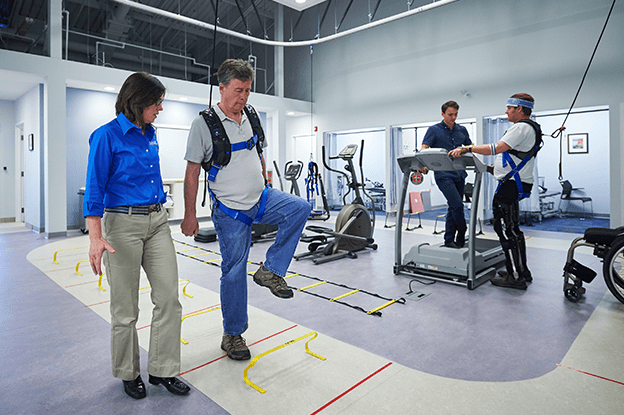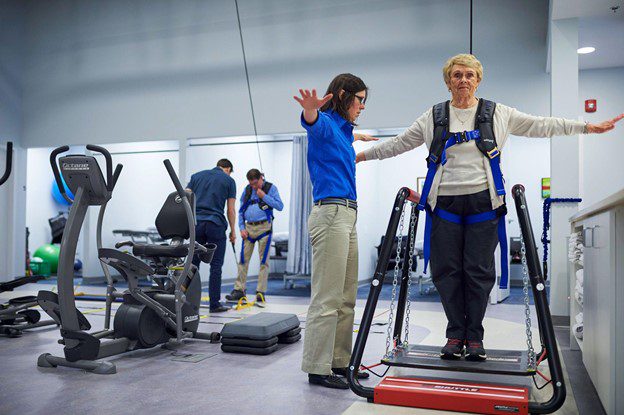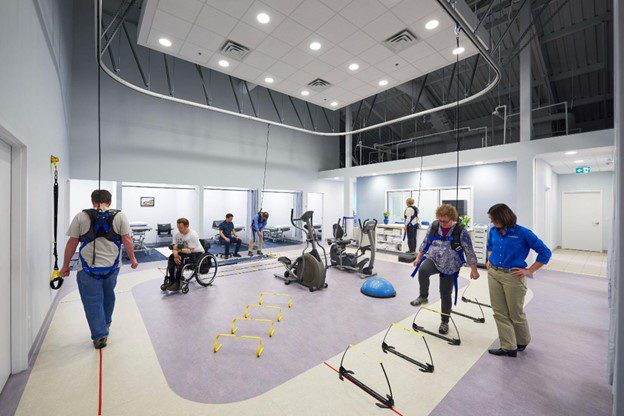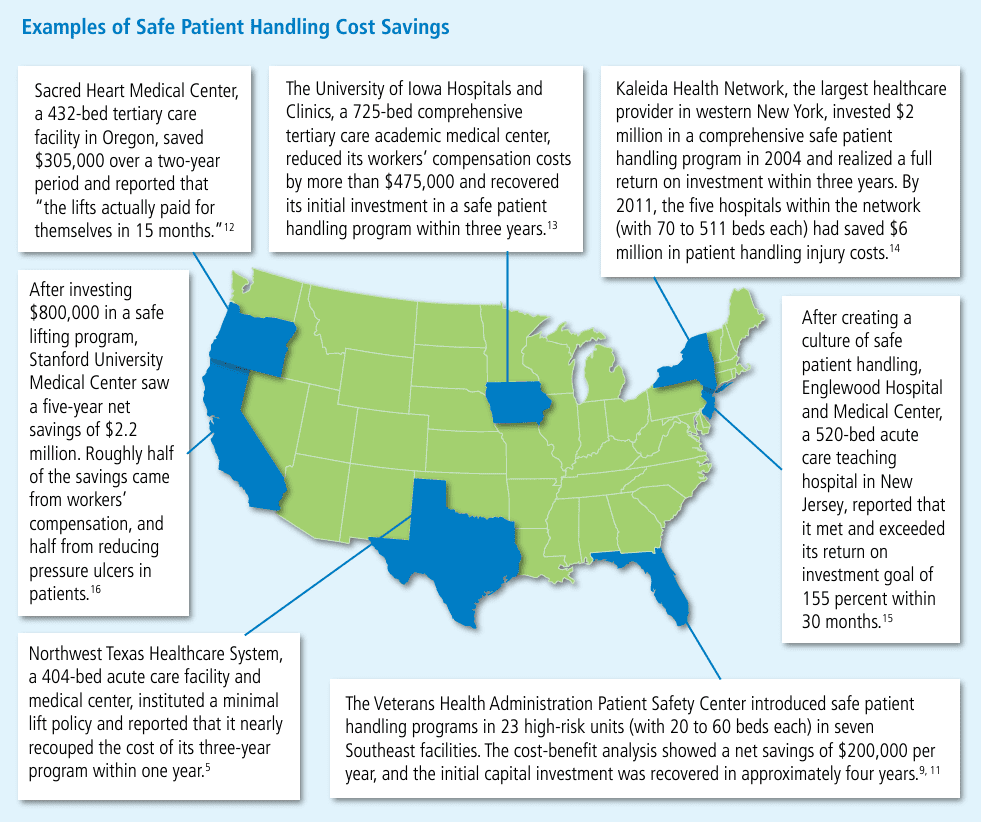The Benefits of Investing in an Overhead Harness System

Overhead harness systems are becoming increasingly essential for patients and physical therapists during rehabilitation. Overhead harness systems like the Solo-Step provide numerous benefits for your facility, including enhanced worker safety, increased productivity, and more. In this blog, we’ll explore the numerous benefits of investing in an overhead harness system and why it’s a game changer for workplace safety.
Enhanced Worker Safety

Physical therapists and healthcare workers who work in clinical environments without adequate equipment, like overhead harnesses, face difficult safety situations. Without proper safety equipment like an overhead harness, your employee may:
- Avoid ambulation practice altogether
- Experience injury while lifting or assisting their patient
- Attempt to provide gait training while guarding patients with minimal equipment, which could result in patient and therapist injuries
Limiting your patients’ therapy due to concern for the patient or staff safety does not allow patients to benefit from a repetitive, intense, and task-specific practice that is recommended for maximizing outcomes. That is why it is important to have adequate equipment to protect the patient and therapists during rehabilitation. Overhead harness systems allow for improved safety and capacity to participate in more advanced exercises.
Are Gait Belts Enough?
Data does suggest that holding a gait belt during a patient fall may decrease the risk of patient injury. However, gait belts are not recommended for catching falling patients. It is also not recommended to lift a patient’s weight with one. This is especially true when working with a patient that is larger than the therapist. Overhead harness systems provide the most safety and comfort needed during gait and balance training.
Does a Lack of Equipment Pose a Risk to Therapists?
Physical therapists involved with patient handling, like gait training, are at a high risk for work-related musculoskeletal disorders. According to the National Institute of Occupational Safety and Health (NIOSH), it is recommended to restrict lifting activities to 35 pounds in an ideal patient environment. However, therapists typically lift more than the recommended amount during mobility activities.
Research investigating work-related musculoskeletal disorders in physical therapists reveals a serious concern. Between 53 and 91% of physical therapists experience a work-related musculoskeletal disorder at some point in their career, with lower back injuries being the most common body part affected. Overhead harness systems like the Solo-Step can help prevent work-related injuries during gait and balance training.
Increased Patient Safety

In addition to staff injuries, there is potential for patient injuries during gait and balance training. Due to fear of falling and not trusting the strength of a therapist, many patients choose to avoid fully participating in therapy. This limits the therapist’s ability to implement high-quality exercises to help patients recover effectively.
Unlike traditional safety measures, like gait belts, overhead harness systems can be adapted to various settings and patient types. Some patients may require additional support during physical therapy. An overhead harness system provides better support than a physical therapist can, which in return protects both patients and therapists from injury.
Overhead harness systems can be placed over specific pieces of equipment to adapt to your patient’s needs. The Solo-Step Overhead Track & Harness system can be combined with many different pieces of equipment, including:
- Treadmills
- Balance boards
- Parallel bars
- Cones
- Slip trainers
- And more
The variety of exercises is endless with an overhead harness system. Using an overhead harness system like the Solo-Step allows you to challenge your patients with various exercises, whether they are low-level or high-level patients.
Overhead Harness Systems Increase Productivity

Overhead harness systems increase the productivity of your staff and your patients. The primary function of overhead harness systems in therapy is to prevent falls and ensure the safety of patients. By providing a secure and controlled environment, therapists can focus on therapeutic interventions without the constant concern for their patient’s safety. This sense of security allows both therapists and patients to engage in activities with more confidence, leading to a more productive therapy session.
Whether your patient is recovering from surgery, injury, or dealing with a neurological condition, a harness system provides support. An overhead harness system allows therapists to facilitate exercises that target specific movements and muscle groups. This targeted approach accelerates the rehabilitation process, increasing the productivity of each therapy session.
Psychological Benefits of Using Overhead Harness Systems

The psychological impacts of using an overhead harness system like the Solo-Step are profound. There are several ways overhead harness systems influence the psychological well-being of individuals, including:
- Increased confidence
- Reduced anxiety
- Encourages active participation
- Increases trust in therapists
- Promotes independence
- Enhances emotional well-being
When your patient is in an overhead harness system like the Solo-Step, they are more confident to attempt higher-intensity exercises without fearing a potential fall or injury. When your patient is confident to attempt new and challenging activities, they are more likely to recover more efficiently.
Overhead Harness Systems Improve your ROI

Implementing an overhead harness system can contribute to a positive return on investment (ROI) in several ways. Some key ways an overhead harness system can enhance ROI include:
- Reduced workplace injuries and costs
- Increased patient and therapist productivity and efficiency
- Compliance with safety regulations
- Enhanced employee satisfaction and retention
- Attracting and retaining staff
- Insurance premium reductions
- Positive brand image
If you would like to see your potential ROI on an overhead harness system like the Solo-Step, visit our ROI Calculator!
The benefits of providing an overhead harness system to your staff and patients extend beyond financial gains, creating a safer, more efficient, and sustainable business environment. If you would like to learn more about the Solo-Step Overhead Track & Harness System, click the link below!